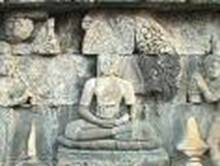Ashtanga Yoga
 Ashtanga Yoga is a term which means “The Eight Limbs of Yoga”. “Astha” means eight, “Anga” means Limbs, and Yoga means Union.
Ashtanga Yoga is a term which means “The Eight Limbs of Yoga”. “Astha” means eight, “Anga” means Limbs, and Yoga means Union.
Ashtanga Yoga is a school of Yoga which seeks to embody the traditional eight limbs of Yoga. The sage Patanjali taught the eight limbs of classical Raja Yoga, outlining them in a treatise he called the Yoga Sutras. To this day, his text remains the single most revered work on Yoga and the definitive source on Rja Yoga. Today, Ashtanga Yoga is also a modern form of Hatha Yoga which was developed by Patthabi Jois, a student of Sri T. Krishnamacharya, who is said to have derived this flowing style of Yoga from a lost book of Patanjali.
With Ashtanga Yoga, the path to internal purification is achieved through eight spiritual steps. Each step must first be mastered before attempting the next step. The first four steps of Ashtanga Yoga are considered to be external cleansing practices and include the following:
 Yama. Yama refers to moral discipline. These are the restrictions, the things we are not to do. This includes the practice of:– Ahimsa/ Nonviolence,
Yama. Yama refers to moral discipline. These are the restrictions, the things we are not to do. This includes the practice of:– Ahimsa/ Nonviolence,
– Satya/ Truth, honesty
– Asteya/ No stealing
– Brahmachaya/ Sexual continence, forbearance, fortitude, kindness, straightforwardness, moderation in diet, and bodily purity.
– Aparigraha/ Nongreed
- Niyama. Niyama refers to self observation. These are the things that we are to do. This includes the practice of:– Saucha/ Physical and mental purity.
– Samtosha/ Contentment, gratitude.
– Tapah/ Austerity, modesty, also acceptance of pain, and not causing pain, and performing sacrifices.
– Svadhhyaya/ Study of teachings and scriptures, repetition of prayers or Japa, observance of vows.
– Isvarapranidhanani/ Accepting the existence of God, worship of God having a discerning mind.
- Asana. Asana means “stability” and “position”. It refers to stability of the mind. One of the different ways to obtain this is through postures. A motionless body makes the mind quiet. There are forty-eight postures which have been described and at least one must be mastered in order to reach a deep meditative state.
- Pranayama. Pranayama refers to “breath control”. This includes inhalation, holding the breath, and exhalation through three types of muscular control (Bandhas).
The next three steps are considered an internal cleansing practices and include the following:
- Pratyahara. Pratyahara refers to “sensory control”. This includes breath suspension and holding the mind which, step by step, absorbs the senses in Kundalini energy.
- Dharana. Dharana refers to “concentration”. This includes a deep concentration on the six subtle centers of the chakras.
- Dhyana. Dhyana refers to “meditation”. The act in which the ego, mind and intellect dissolve in Kundalini. Kundalini thus, dissolves into the supreme consciousness.
The final step of Ashtanga Yoga is as follows:
- Samadhi. Samadhi refers to “ecstasy”, “bliss” and “nirvana”. This is the state in which individual consciousness becomes pure consciousness. Because the conscious connection with the divine becomes everlasting after a prolonged state of samadhi, completion of this step means that there is no longer a need to practice Ashtanga Yoga.
Ashtanga Yoga Table of Contents
- What is Ashtanga Yoga?
- Pattabhi Jois
- The Eight Limbs
- Ashtanga yoga mantra
- Ujjayi Breath
- Locks / Bhandas
- Drishti / Gaze
- Vinyasa
- Surya Namaskara / Sun Salutation
- Standing poses
- Padangusthasana
- Padahastasana
- Utthita Trikonasana
- Parivritta Trikonasana
- Utthita Parsvakonasana
- Parivritta Parsvakonasana
- Prasarita Padottanasana A
- Prasarita Padottanasana B
- Prasarita Padottanasana C
- Prasarita Padottanasana D
- Parsvottanasana
- Utthita Hasta Padangusthasana A
- Utthita Hasta Padangusthasana B
- Utthita Hasta Padangusthasana C
- Utthita Hasta Padangusthasana D
- Ardha Baddha Padmottanasana
- Utkatasana
- Virabhadrasana A
- Virabhadrasana B
- Primary Series
- Dandasana
- Paschimottanasana A
- Paschimottanasana B
- Paschimottanasana C
- Purvottanasana
- Ardha Baddha Padma Paschimottanasana
- Trianga Mukhaikapada paschimottanasana
- Janu Sirsasana A
- Janu Sirsasana B
- Janu Sirsasana C
- Marichyasana A
- Marichyasana B
- Marichyasana C
- Marichyasana D
- Navasana (5 times)
- Bhujapidasana
- Kurmasana
- Supta Kurmasana
- Garbha Pindasana
- Kukktasana
- Baddha Konasana A
- Baddha Konasana B
- Upavishta Konasana A
- Upavishta Konasana B
- Supta Konasana
- Supta Padangusthasana A
- Supta Padangusthasana B
- Supta Padangusthasana C
- Ubhaya Padangusthasana
- Urdhva Mukha Paschimottanasana
- Setu Bandhasana
- Intermediate Series
- Finishing Series
- Poster To Go
